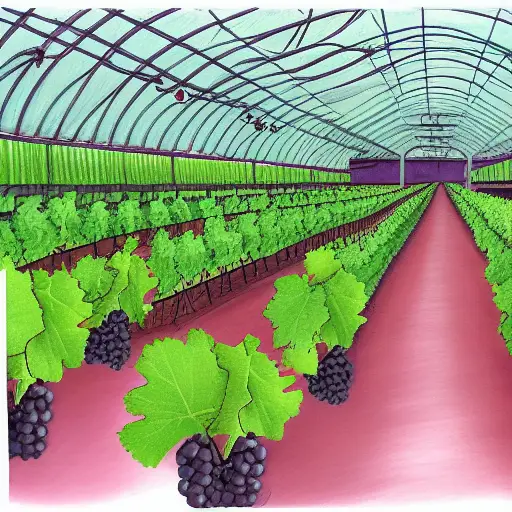If you are wondering how to grow grapes in a greenhouse, there are some tips to keep in mind. You must plant grapevines in their correct locations and avoid pests and diseases. In addition, you should plant grapevines at the right time of the year. You will also need to prune side branches to 2 buds each year in November.
Growing grapes in a greenhouse
Growing grapes in a greenhouse has its benefits. For example, it can provide a cooler environment for the plant’s roots. This is a great benefit, because growing grapes indoors can cause the soil to become sour and prevent the plant from producing a harvest. The most important thing when planting a grapevine is to make sure it has good drainage. The minimum size of the vine border should be 1.5 meters by 3 meters, but smaller borders can still produce good grapes. When preparing the soil, it should be dug to a depth of 75 cm. Then, a layer of fifteen to twenty-five cm of rubble should be placed over the soil.
Once planted, the grapevine should be placed near the end of the greenhouse, away from the main entrance. This will ensure that the vine doesn’t block the door. As grapes grow quickly, they will take up a lot of space, so it is important to prune them regularly. Once the crop has finished, the grapes can be transplanted to an outside space.
When growing grapes in a greenhouse, it is important to choose the right type for your growing conditions. Grape vines are heavy and need a lot of support. Use strong wires, preferably thirty centimeters apart, to support them. In addition, you should tie the vines together using soft string.
Grapevines need good watering during their growing season. Grapes growing outside a greenhouse need watering more frequently, while those grown inside require weekly watering. It is also important to make sure that the greenhouse is humid enough to prevent the plant from drying out. Grapevines may also need pollination. Pollination can be done manually or by using a feather. In addition, the grapevines can benefit from mulching with well-rotted manure in spring and placing straw around the roots during the summer to facilitate fruit setting.
Planting grapevines in a greenhouse
The first step when planting grapevines in a greenhouse is to prepare the growing space. The walls of the greenhouse should have a ridge. The soil should be moist and warm. The soil should be topped up with a good quality compost. Vines should be planted at intervals of about 2.1 m.
Grapevines require regular watering throughout the growing season. Water deeply once or twice a week to maintain healthy growth. In containers, you may need to water more often. If you’re growing grapevines in a greenhouse, you may want to install a drip irrigation system. This is a simple way to ensure a consistent water supply.
Grapevines grow best in rich soil. They need 6-8 hours of direct sunlight each day. If your greenhouse is shady, you can use shade cloths to help provide shade. They also need plenty of indirect light. To ensure the health of your grapes, fertilize the soil with organic matter.
Grapevines have extensive root systems. This means that they can take up a lot of greenhouse space. So, make sure that you have enough space for them to spread their roots properly. Ideally, they should be planted at least two feet apart from each other and far away from other plants.
The next step when planting grapes in a greenhouse is to train the vine. You can do this by either placing the root outside or inside the greenhouse. The former method is best if you have a small greenhouse or multiple grape varieties.
Preventing pests and disease
The first step in growing grapes in a greenhouse is selecting the right soil. Different soils have different moisture and texture. You should choose a mix with organic material that helps retain moisture and improve drainage. In addition, the ideal growing temperature for grapevines is between 77 and 90 degrees Fahrenheit. Grapevines need warm temperatures to grow and develop. However, too much heat in a greenhouse can cause the plant to suffer.
Grapevines should be planted two to three feet apart, and they should have plenty of space to spread their roots. Plant them at least two feet apart from other plants in the greenhouse, so that they don’t crowd each other. It is also a good idea to prune diseased tissue.
A balanced fertilizer is essential for healthy growth and disease prevention. It contains nitrogen, phosphorus, and potassium. It should be applied monthly during the growing season. Keeping an eye out for pests and disease is a must for grape cultivation. However, grapevines grown in a greenhouse have a certain level of protection against these pests.
Pierce’s disease (also known as bacterial leaf scorch) is another disease that needs to be monitored to ensure that the crop is not damaged by the disease. This disease is caused by a combination of fungi, bacteria, and yeast. Grapes that are damaged by the disease are generally affected and their yield can be reduced. This disease can be fatal to grapevines.
Another problem to watch out for is powdery mildew. This is a fungal disease that can cause severe defoliation of plants. If left untreated, it can lead to rot and stunting. Copper fungicides can be used to control this disease.
Best time of year to plant grapevines in a greenhouse
The best time to plant grapevines in a greenhouse is during early spring. Grapevines need full sun for the best growth, although they can tolerate a little afternoon shade. They also need deep, moist soil that breathes well. They will need support for upward growth, and they don’t like soil that’s too acidic.
Grapevines grow quickly and produce lots of leaf. In early spring, they need to be watered every day at least once, but this should be repeated every few days throughout the growing season. Fertilizer should be applied to the plants daily, in the early morning. If you are planting grapes in containers, you can use Maxicrop or Miracle Grow fertilizers.
It is best to plant grapevines with the roots outside, but you can also plant them inside if you’re growing more than one variety. In either case, you’ll want to be very vigilant with watering, and it’s easier to grow grapes indoors if the soil is warmer.
Grapevines grow substantially, and require a lot of space. If you’re working with a small greenhouse, limit the number of grapevines you grow. A grapevine should not be planted in a large container. If you’re limited on space, consider growing only one grapevine in a tub, so you can control the roots.
Ideally, grapes grow best in slightly acidic soil. They do well in soil with a pH of 5.5 to 7.0. However, grapevines are not tolerant of heavy clay soil. A heavy clay soil can hold too much water and result in root rot.
Growing grapes in a greenhouse with a drip hydroponic system
Growing grapes in a greenhouse with s drip hydroponic system requires some preparations. To begin, it’s important to prepare the soil before planting. Compost is essential to a healthy grape plant, since it helps drain the soil and adds nutrients. Grapes vary in pH requirements, so be sure to read up on your local conditions before planting your grapes. For most types, a baseline pH of 5.5-6.0 is good. For Vitis vinifera and hybrid varieties, it should be 6.5-7.0.
Grapevines should be planted as early as possible once the risk of frost has passed. You may wish to purchase pre-planted grape vines, or even start your vineyard from seed. Grape seeds need stratification to germinate properly. This process involves putting the seeds in a refrigerator for three months or more.
Grape vines can be quite vigorous, so you should have cutting equipment ready to cut them when necessary. Grape vines can also be trained in a fan or cordon style to fit a tight space. To train vines, use a trellis or other structure that supports the vines. A trellis is essential to support the weight of the developing fruit.
Another essential part of a greenhouse hydroponic system is a heating system. In colder weather, a low-quality heating system can damage your crop. Without proper heating, you could even lose the entire crop in one or two cold nights. Fortunately, commercially available controllers are available that help you control the various components of your production site. One such controller, the GrowDirector Controller, can manage all the elements of your growing system smartly and automatically. It’s easy to use, and it provides direct access to key growing parameters.
Grapes are part of the Vitis family. There are 79 species, but not all of them produce edible fruit. Grapes can be grouped into three basic categories. These categories are California grapes, Italian grapes, and American grapes.










